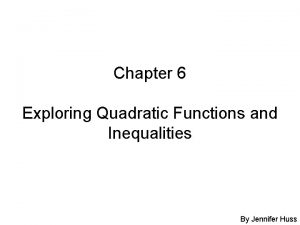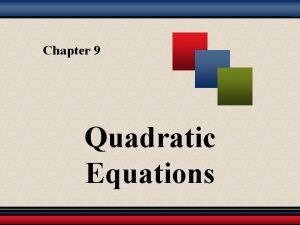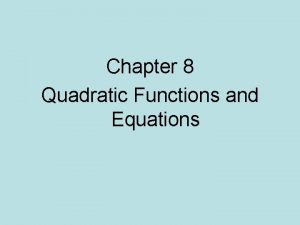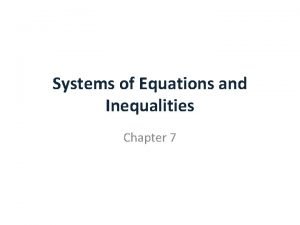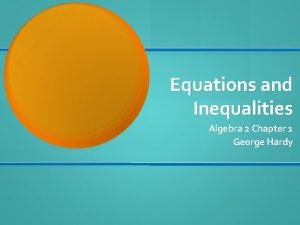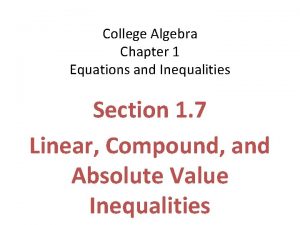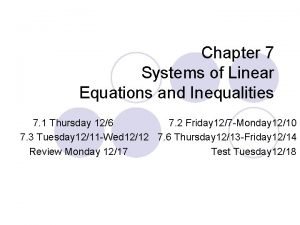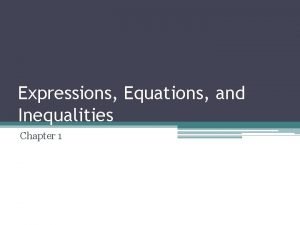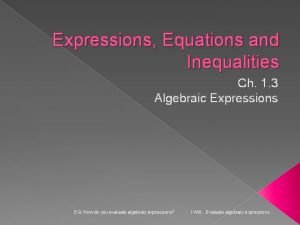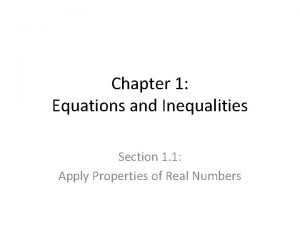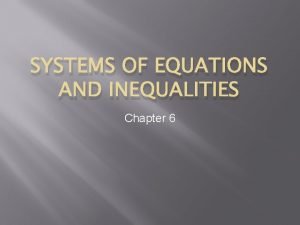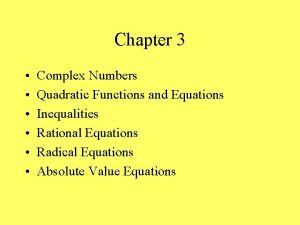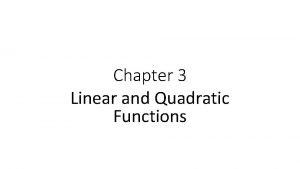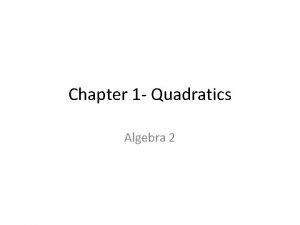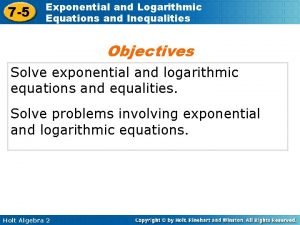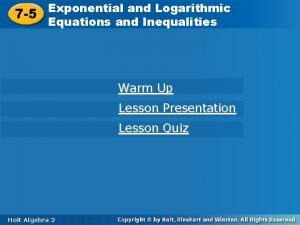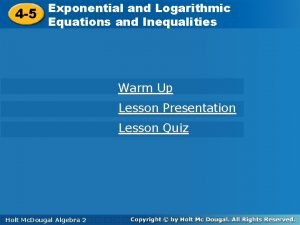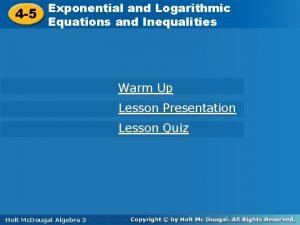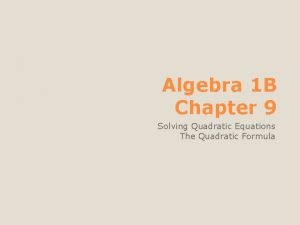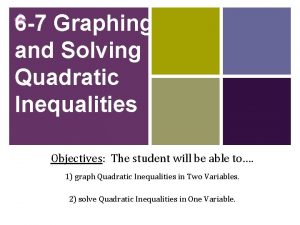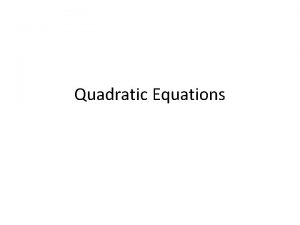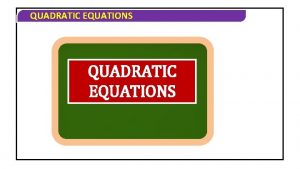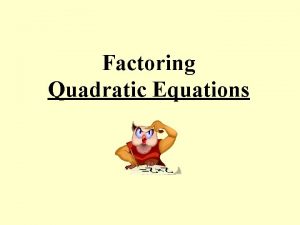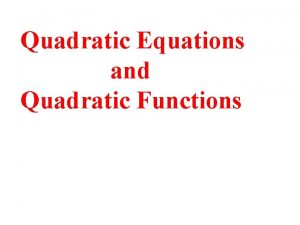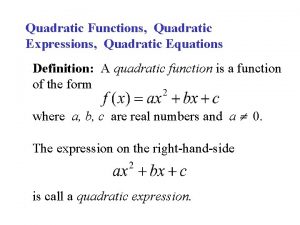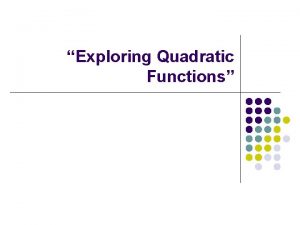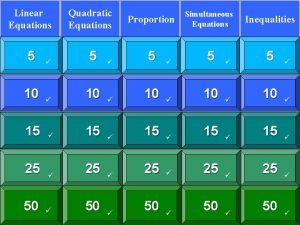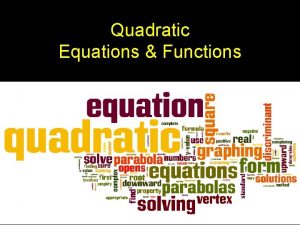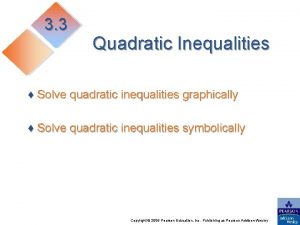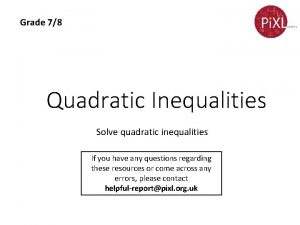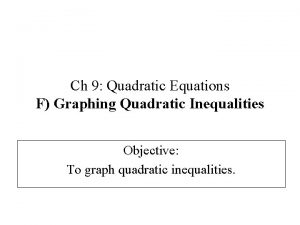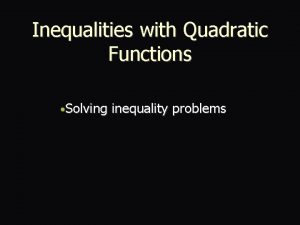CHAPTER 3 Quadratic Functions and Equations Inequalities 3




















- Slides: 20


CHAPTER 3: Quadratic Functions and Equations; Inequalities 3. 1 The Complex Numbers 3. 2 Quadratic Equations, Functions, Zeros, and Models 3. 3 Analyzing Graphs of Quadratic Functions 3. 4 Solving Rational Equations and Radical Equations 3. 5 Solving Equations and Inequalities with Absolute Value Copyright © 2009 Pearson Education, Inc.

3. 2 Quadratic Equations, Functions, Zeros, and Models · · · Find zeros of quadratic functions and solve quadratic equations by using the principle of zero products, by using the principle of square roots, by completing the square, and by using the quadratic formula. Solve equations that are reducible to quadratic. Solve applied problems using quadratic equations. Copyright © 2009 Pearson Education, Inc.

Quadratic Equations A quadratic equation is an equation that can be written in the form ax 2 + bx + c = 0, a 0, where a, b, and c are real numbers. A quadratic equation written in this form is said to be in standard form. Copyright © 2009 Pearson Education, Inc. Slide 3. 2 - 4

Quadratic Functions A quadratic function f is a function that can be written in the form f (x) = ax 2 + bx + c, a 0, where a, b, and c are real numbers. The zeros of a quadratic function f (x) = ax 2 + bx + c are the solutions of the associated quadratic equation ax 2 + bx + c = 0. Quadratic functions can have realnumber or imaginary-number zeros and quadratic equations can have real-number or imaginary-number solutions. Copyright © 2009 Pearson Education, Inc. Slide 3. 2 - 5

Equation-Solving Principles The Principle of Zero Products: If ab = 0 is true, then a = 0 or b = 0, and if a = 0 or b = 0, then ab = 0. Copyright © 2009 Pearson Education, Inc. Slide 3. 2 - 6

Example Solve 2 x 2 x = 3. Solution Copyright © 2009 Pearson Education, Inc. Slide 3. 2 - 7

Example - Checking the Solutions Check: x = – 1 Check: TRUE The solutions are – 1 and TRUE Copyright © 2009 Pearson Education, Inc. Slide 3. 2 - 8

Equation-Solving Principles The Principle of Square Roots: If x 2 = k, then Copyright © 2009 Pearson Education, Inc. Slide 3. 2 - 9

Example Solve 2 x 2 10 = 0. Solution Check: TRUE The solutions are and Copyright © 2009 Pearson Education, Inc. Slide 3. 2 - 10

Completing the Square To solve a quadratic equation by completing the square: 1. 2. 3. 4. 5. 6. Isolate the terms with variables on one side of the equation and arrange them in descending order. Divide by the coefficient of the squared term if that coefficient is not 1. Complete the square by taking half the coefficient of the first-degree term and adding its square on both sides of the equation. Express one side of the equation as the square of a binomial. Use the principle of square roots. Solve for the variable. Copyright © 2009 Pearson Education, Inc. Slide 3. 2 - 11

Example Solve 2 x 2 1 = 3 x. Solution The solutions are Copyright © 2009 Pearson Education, Inc. Slide 3. 2 - 12

Quadratic Formula The solutions of ax 2 + bx + c = 0, are given by This formula can be used to solve any quadratic equation. Copyright © 2009 Pearson Education, Inc. Slide 3. 2 - 13

Example Solve 3 x 2 + 2 x = 7. Find exact solutions and approximate solutions rounded to the thousandths. Solution: 3 x 2 + 2 x 7 = 0 a = 3, b = 2, c = 7 The exact solutions are: The approximate solutions are – 1. 897 and 1. 230. Copyright © 2009 Pearson Education, Inc. Slide 3. 2 - 14

Discriminant When you apply the quadratic formula to any quadratic equation, you find the value of b 2 4 ac, which can be positive, negative, or zero. This expression is called the discriminant. For ax 2 + bx + c = 0, where a, b, and c are real numbers: b 2 4 ac = 0 One real-number solution; b 2 4 ac > 0 Two different real-number solutions; b 2 4 ac < 0 Two different imaginary-number solutions, complex conjugates. Copyright © 2009 Pearson Education, Inc. Slide 3. 2 - 15

Equations Reducible to Quadratic Some equations can be treated as quadratic, provided that we make a suitable substitution. Example: x 4 5 x 2 + 4 = 0 Knowing that x 4 = (x 2)2, we can substitute u for x 2 and the resulting equation is then u 2 5 u + 4 = 0. This equation can then be solved for u by factoring or using the quadratic formula. Then the substitution can be reversed by replacing u with x 2, and solving for x. Equations like this are said to be reducible to quadratic, or quadratic in form. Copyright © 2009 Pearson Education, Inc. Slide 3. 2 - 16

Solving an Equation Reducible to Quadratic - Example Solve: x 4 5 x 2 + 4 = 0. Solution x 4 5 x 2 + 4 = 0 u 2 5 u + 4 = 0 (substituting u for x 2) (u 1)(u 4) = 0 u 1 = 0 or u 4 = 0 u = 1 or u=4 x 2 = 1 or x 2 = 4 (substitute x 2 for u x = ± 1 or x = ± 2 and solve for x) The solutions are 1, 1, 2, and 2. Copyright © 2009 Pearson Education, Inc. Slide 3. 2 - 17

Applications (optional) Some applied problems can be translated to quadratic equations. Example Time of Free Fall. The Petronas Towers in Kuala Lumpur, Malaysia are 1482 ft tall. How long would it take an object dropped from the top reach the ground? Copyright © 2009 Pearson Education, Inc. Slide 3. 2 - 18

Example (continued) (optional) 1. Familiarize. The formula s = 16 t 2 is used to approximate the distance s, in feet, that an object falls freely from rest in t seconds. 2. Translate. Substitute 1482 for s in the formula: 1482 = 16 t 2. 3. Carry out. Use the principle of square roots. Copyright © 2009 Pearson Education, Inc. Slide 3. 2 - 19

Example (continued) (optional) 4. Check. In 9. 624 seconds, a dropped object would travel a distance of 16(9. 624)2, or about 1482 ft. The answer checks. 5. State. It would take about 9. 624 sec for an object dropped from the top of the Petronas Towers to reach the ground. Copyright © 2009 Pearson Education, Inc. Slide 3. 2 - 20
 Exploring quadratic graphs
Exploring quadratic graphs Chapter 9 quadratic equations and functions
Chapter 9 quadratic equations and functions Chapter 8 quadratic functions and equations
Chapter 8 quadratic functions and equations Chapter 7 systems of equations and inequalities
Chapter 7 systems of equations and inequalities Chapter 1 equations and inequalities answer key
Chapter 1 equations and inequalities answer key College algebra equations and inequalities
College algebra equations and inequalities Chapter 7 systems of equations and inequalities answers
Chapter 7 systems of equations and inequalities answers Chapter 1 expressions equations and inequalities
Chapter 1 expressions equations and inequalities Chapter 1 expressions equations and inequalities
Chapter 1 expressions equations and inequalities Chapter 1 equations and inequalities
Chapter 1 equations and inequalities Chapter 6 systems of equations and inequalities
Chapter 6 systems of equations and inequalities Chapter 3 quadratic equations and complex numbers answers
Chapter 3 quadratic equations and complex numbers answers Chapter 3 linear and quadratic functions
Chapter 3 linear and quadratic functions Chapter 1 quadratic functions and factoring
Chapter 1 quadratic functions and factoring Log to exponential
Log to exponential Solving exponential and logarithmic equations quiz
Solving exponential and logarithmic equations quiz Exponential equation and inequalities
Exponential equation and inequalities Logarithmic inequalities examples
Logarithmic inequalities examples Exponential and logarithmic equations and inequalities
Exponential and logarithmic equations and inequalities Chapter 9 solving quadratic equations
Chapter 9 solving quadratic equations How to solve and graph quadratic inequalities
How to solve and graph quadratic inequalities
